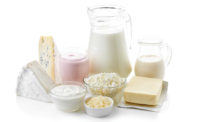It has been quite a year for the dairy industry. Its challenges are many — from ongoing labor and supply chain issues to higher consumer expectations and increased competition from dairy alternatives.
Dairy Foods asked the leading executives from a number of large dairy companies and cooperatives to discuss the industry’s most significant challenges, as well its greatest opportunities.
Participants include Patrick Criteser, president and CEO of Tillamook County Creamery Association, Tillamook, Ore.; Joe Diglio, president and CEO, Michigan Milk Producers Association, Novi, Mich.; Shane Grant, CEO, Danone North America, White Plains, N.Y., and Broomfield, Colo.; Ed Mullins, CEO and executive vice president, Prairie Farms Dairy, Edwardsville, Ill.; Tim Omer, president and managing director, Emmi Roth, Fitchburg, Wis.; and Dennis Rodenbaugh, executive vice president and president, council operations and Ingredient Solutions, Dairy Farmers of America, Kansas City, Kan.
Dairy Foods: What do you view as the most significant challenges to the dairy industry today, and why?
Patrick Criteser: Consumers’ expectations of dairy are climbing — they expect brands to not only be good-tasting but also good for the community and good for the planet. The dairy industry has a responsibility and an opportunity to demonstrate the ways in which dairy producers and processors are good stewards of the land, communities, and people.
Joe Diglio: Many industries, including dairy, have experienced challenges with labor and supply shortages that have intensified in recent months. Labor has been a challenge not just at the processing level, but also at the producer level on the farm. Equally impactful, the supply chain has been disrupted with escalated costs on transportation and lack of available resources to help facilitate product distribution.
These challenges have also created additional obstacles in getting our products to those in need of dairy’s nutrients both domestically and internationally. In addition to supply chain issues, the dairy industry could and should improve the messaging of the benefits of our products and develop momentum for product evolution to keep dairy relevant in households. Dairy is the most nutritional product around.
Shane Grant: The past year and a half has been full of firsts for everyone — consumers and companies alike. Our focus throughout has been prioritizing employee health and safety while serving our customers, so our consumers can access the products they know and love amidst the unprecedented global pandemic.
Beyond that, we have put a lot of energy into ensuring we are staying ahead of the curve with our brands — driving growth with our core dairy portfolio and focusing on scaling relevant innovations as conventional consumption habits and behaviors shifted and existing trends accelerated.
Ed Mullins: The availability of labor causing supply chain issues and filling labor shortages.
Tim Omer: The short-term challenge is staffing and workforce development. The long-term challenge is how the industry addresses sustainability and turns our industry’s greatest weakness into our greatest strength. Our industry’s long-term success is dependent on sustainable growth and a healthy planet.
Dennis Rodenbaugh: Our industry faces numerous important and interrelated areas of focus. Supporting our farmer’s livelihoods and their markets for future generations is a core value that aligns with one of our key objectives to ensure consumers prioritize dairy as a complete package of wholesomeness, flavor, and nutrition. At the same time, it’s critical that consumers understand that dairy also serves a positive role in sustainability and environmental health.
Dairy Foods: What will it take to overcome these challenges?
Criteser: In order to be successful in tackling big industry challenges, like dairy’s impact on climate change, we need to bring dairy farmers to the table. Already, dairy producers have found innovative ways to protect our ecosystems, from regenerative agricultural practices to converting manure into energy and air-quality improvements. We must involve dairy farmers in decision-making in order to create long-lasting, positive impacts.
Diglio: When you look at the different challenges facing our industry, collaborating and partnering with others is an opportunity to create solutions that will positively impact the dairy industry. Teaming up with universities and communities to tout the benefits of being involved in an industry whose values and goals align with the newer workforce can help alleviate some of the current challenges.
The industry needs to continue streamlining the infrastructures in place today, find sustainable solutions that enhance awareness and encourage product evolution to serve customer expectations. Partnerships and investment are going to be key to overcome challenges and create long-term opportunities.
Grant: Whether we’re confronted with a global pandemic or another event, if the dairy industry keeps a deep understanding of the consumer at the forefront of everything it does, we believe Danone, the industry, and dairy brands will continue to be successful.
We know that COVID shifted some conventional consumer and shopping behaviors. But beyond these reactive, shorter-term shifts, we’ve seen massive multi-year acceleration of trends. Many of these trends existed prior to the pandemic but have now been rapidly accelerated at a large scale. Listening carefully to consumers as these broader category trends accelerate will enable the industry to stay ahead of the curve and capture growth opportunities.
For example, at Danone North America, as interest in products that support health — be it immunity, gut health, protein, specific functional benefits, and even moments of indulgence — continued to increase, we launched new innovations to meet these needs. For example, we modernized our Activia brand to drive a contemporary “gut health” message and have seen sustained growth and share acceleration. Under Oikos, we launched a new sub-brand called Oikos Pro in January 2021 featuring high-protein, functional yogurt cups, and beverages that serve a new consumption occasion and the high-protein trend. In June 2021, we launched Oikos Blended, a new line of yogurt packed with protein that offers a “forkable” taste experience (50% more fruit* and thick, creamy texture) to excite millennials and tap into both lower sugar and indulgence demand.
Another brand example is our Horizon Organic Growing Years line. Following the success of the Horizon Organic Growing Years milk launch in early 2020, we expanded the line this past year to meet the needs of growing kids and parents focused on health and wellbeing. The new products were developed in partnership with pediatricians, and fortified with DHA, choline, and other nutrients, and include new low-fat yogurt pouches, cultured dairy smoothies, reduced-fat milk half-gallons, and single-serve whole-milk boxes.
Specifically with purchasing and consumption occasions, we have seen some big structural shifts. The most pronounced has been increased adoption of digital — we have seen a 3X step-up in ecommerce as a portion of our business, and we are winning that critical shift.
In addition, as new at-home consumption occasions have sustained, including more time spent cooking and on breakfast, there have been opportunities in packaging. For example, by bundling together multiple brands in our portfolio and offering larger sizes.
Mullins: Capital expenditures for automation.
Omer: We need to look at continued automation, offer greater flexibility, and create meaningful work to address staffing and workforce challenges.
In regards to sustainability, we are all responsible for doing our part to reduce our impact while driving positive change throughout the industry. We need to have clear paths towards sustainability efforts, assign individuals in our organizations to lead these efforts, and keep each other and ourselves accountable. Our team here at Emmi Roth is developing a local standard for our milk suppliers and a plan to reduce our emissions, waste, and water.
Rodenbaugh: Despite the overwhelming nutritional benefits dairy offers, the expanse of consumer food products, particularly in the beverage category, is complicated by a confusing array of lesser nutritional alternatives. It’s critical that we continually innovate how we deliver dairy in all its forms, functions, and flavors to enhance consumers’ connection to and demand for the complete health and wellness package that dairy provides.
Through solutions like convenient packaging, new flavors, and functionality, we must find new ways to build relationships with consumers. To continue to generate demand, we rely on consumer insights that help us understand how we best provide relevant and differentiated dairy products to deliver the best nutritional value.
Another way that we reach consumers today is through our relationships with customers, who we partner with to deliver solutions, solve problems and support their need for dairy to meet consumer expectations. To that end, expanding customer and consumer relationships in the United States and globally is critical to providing dairy farm families with market access and demand growth opportunities. These relationships will maximize the value of milk and the opportunity for profitability as farmers continue to manage through volatile input costs.
We need to stay focused and nimble in how we help manage the unpredictability of markets today. As an example, DFA’s risk management team offers a full array of innovative solutions and market insights to help our family farm-owners and customers manage market volatility and maximize margin opportunity.
We also have a great sustainability story to tell, and we need to create a positive relationship with consumers as we share our commitment to a healthy environment and population. U.S. dairy farm families have always demonstrated leadership, commitment, and tremendous results by providing nutrition to a growing global population, while simultaneously shrinking their environmental footprint and use of natural resources. Sustainable technologies like anaerobic digesters and solar power must become more accessible to dairy farmers to support these continued improvements.
I believe there will be incredible innovation and technology breakthroughs in the next decade that will exponentially impact how our farmers continue to lead in environmental health initiatives. But we are also actively showing consumers what our farmers are already doing to reach net-zero emissions through the Nerd Herd, which is how we’re telling DFA’s sustainability story to consumers.
Made up of all the individuals within various areas of expertise that support farmers on their sustainability journey, through the Nerd Herd, we’re sharing a range of on-farm initiatives with consumers and showing how in partnership with our farmers, agronomists, engineers, technical innovators, veterinarians, nutritionists, researchers, and scientists, along with DFA employees, we are progressing in meeting our net-zero goal.
Dairy Foods: Looking ahead to the next year and beyond, what are you most excited about, in terms of growth opportunities, for the dairy industry?
Criteser: I believe the dairy industry has an exciting opportunity to show up as innovators and thought leaders to address some of these big challenges and deliver on consumer expectations. Lifting up farmer voices can also help shorten the distance between consumers and food producers and educate consumers about where their food comes from.
One of the ways TCCA is working to help farmers across the nation and educate consumers about where their food come from is through the All for Farmers Coalition. Together with American Farmland Trust, we created this coalition to raise funds for the Brighter Future Fund, which is a grant program that ensures every dollar raised goes directly to a farmer in need. We worked with a few farmers across the country to share their stories and show consumers the barriers farmers face to keep food on our tables. Now is the time to refocus the conversation and reconnect consumers to the source of their food.
Diglio: The dairy industry is headed in the right direction in terms of product innovation, and we’re excited to see how this will lead to growth opportunities in many product categories. Whether it is producing a different product mix, securing a different product destination, or helping in sustainability efforts, dairy is an industry that is ripe for a multitude of opportunities that will improve our communities and dairy’s value proposition for everyone.
Grant: Dairy is a growth industry. Dairy is the largest component of our Danone North America business and is a growth engine. We see many drivers that excite us.
With consumers, we see shifts towards health — immunity, gut health, protein, functional benefits, and even moments of indulgence — as key dairy drivers. The specific core brand and innovation opportunities mentioned above are examples of how we are driving towards those opportunities with our dairy business — delivering nutritious, great-tasting products to help support the growing interest in healthy lifestyles.
In addition, we know and have seen how expandable dairy occasions can be. We see expansion through growing breakfast occasions, the demand for protein on the go or pre/post-workout, an increase in flexitarian households where we can grow both plant-based and dairy in tandem, and the proven growth and relevance we can drive through digital channels.
Finally, we know that consumers are increasingly looking for products and services that align with purpose. As one of the world’s largest certified B Corporations that puts purpose at the core of each part of our business, this consumer mindset is energizing for us and our mission. Our growth plan in the U.S. is rooted in growing, and building, consumer-centric ‘manifesto brands’ — and many of our brands are centered around a deep purpose. We are convinced that purpose and performance [are] interconnected — and we have that embedded that in our growth strategy and brands.
One example of how being purpose-driven is resonating with consumers is the success of our Two Good yogurt brand, which we introduced to the Greek yogurt market in 2019. The brand was founded with a purpose to “do more with less” — in addition to having less sugar due to a unique straining process, the brand is committed to reducing food waste nationwide. The brand’s Good Save line, in partnership with Full Harvest (a produce-rescue startup) uses rescued fruit that would have otherwise gone to waste. And its One Cup Less Hunger program, a one-for-one program in collaboration with food rescue groups like City Harvest and We Don’t Waste, helps address the interrelated challenges of food insecurity and food waste.
The brand’s actions to positively impact society and the environment resonate with consumers: Two Good has grown into over a $200M brand in just three years; it is one of the fastest-growing yogurt brands in the U.S. today and a top contributor to dollar growth for the entire yogurt category. This is a great example of how being purpose-driven helps fuel our business performance, and we believe there are many more opportunities across the industry to capture consumers by infusing purpose and action into brands.
Mullins: The return of family meals, cooking opportunities, and showcasing the healthy benefits of dairy products.
Omer: As we move forward this year and beyond, I am excited to see the dairy industry continue to grow with the ever-evolving consumer. Consumer behavior has changed forever, and that has presented opportunities for the dairy industry as we provide clean, meaningful natural products, growing sales opportunities, and can develop innovative new products that people need and want.
Rodenbaugh: There is so much to be optimistic about when you look at the overall dairy industry. As a whole, the dairy category remains a strong and diverse sector in the United States, achieving growth in per-capita consumption for 25 years in a retail category worth over $100 billion today. Cheese and butter are at all-time consumption highs, and 94% of U.S. households are buying fluid milk … real, authentic milk!
Along with serving U.S. consumers, we remain committed to supporting growing global demand for dairy. Since the creation of DFA in 1998, we’ve worked to develop opportunities in the global dairy market, and it’s exciting to see how we are uniquely positioned to meet growing global demand for dairy — in all of its amazing forms, functions, and flavors — that takes us beyond the traditional dairy case to support health and wellness to a growing world population.
*50% more fruit than previous Oikos Strawberry, Blueberry, Peach and Cherry Greek yogurts










